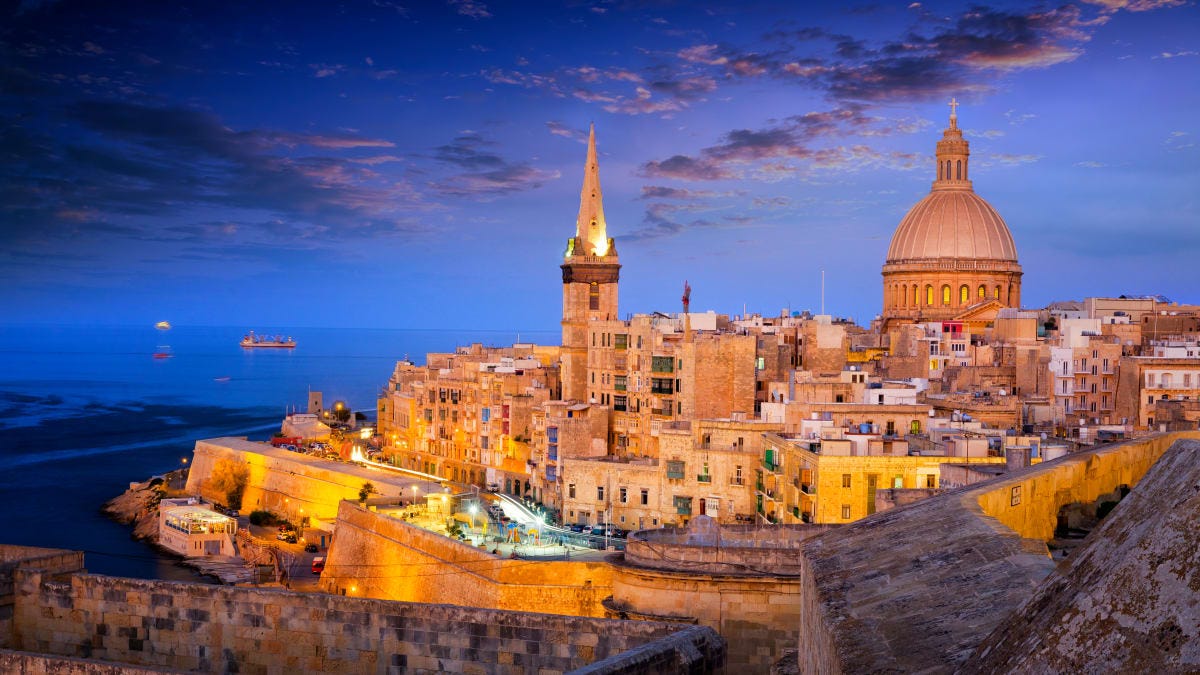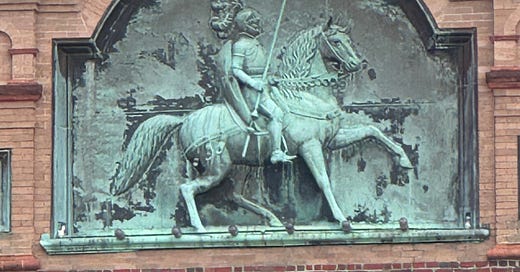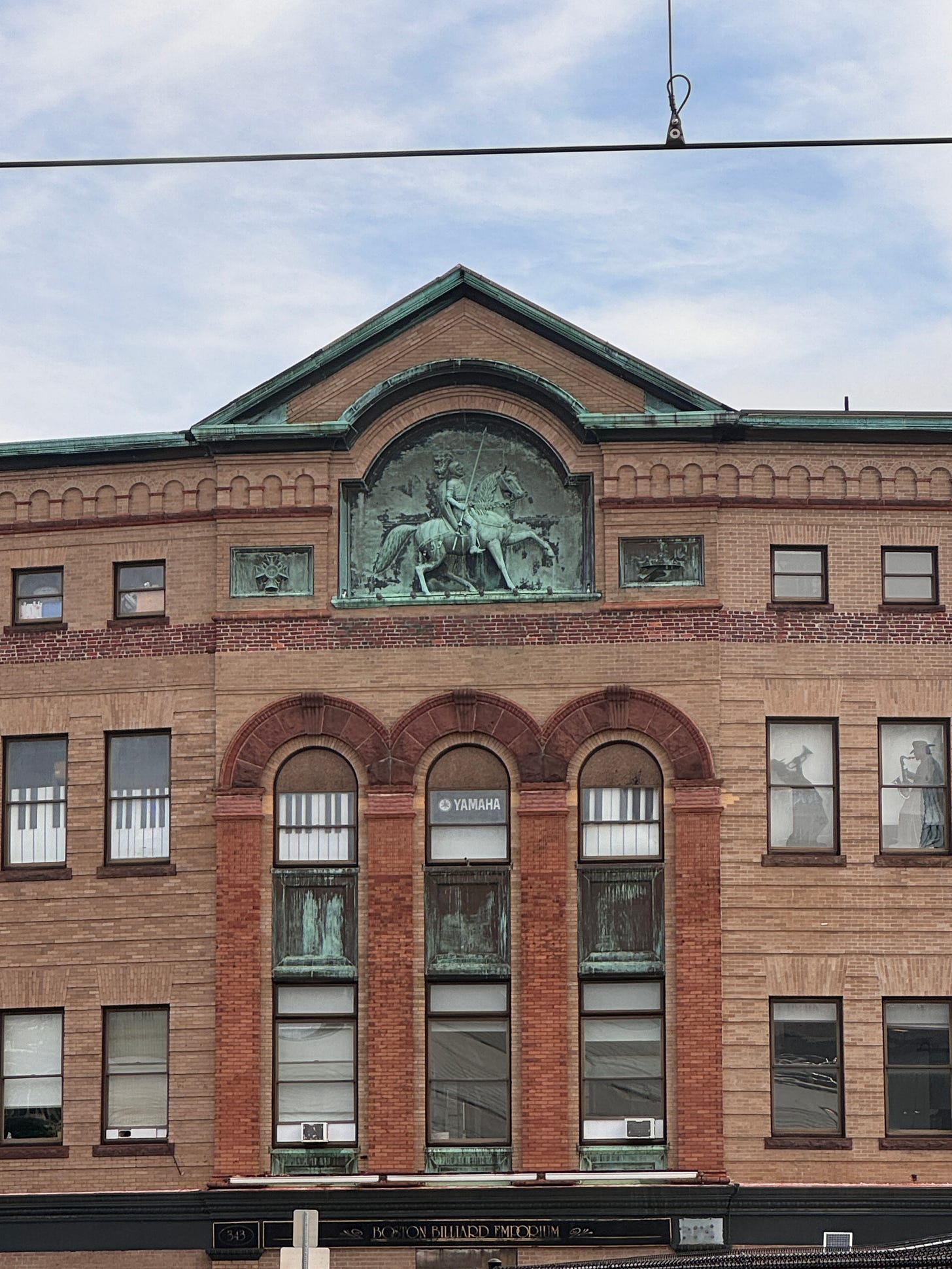I have been AWOL for some time from the blog. Life happens, you know. In the good news department, the first draft of my book is complete. Returning to our theme, though:
If you live in America, as I do, you may think the Middle Ages are long ago and far away. And you would mostly be right. But…
My oldest granddaughter, a toddler, loves trains. A few days ago we decided to ride the ever-so-modern Green Line subway extension here in Boston. Recently completed, it runs from Lechmere Station, near our residence, to Tufts University, making a stop at Gilman Square in Somerville; I have never been there. Glancing out the window of the subway car, I see this:
What? A Medieval Knight on a building? Whaaa? I did not trust my eyes, so I took a picture, zoomed in, and sure enough, knight, horse, lance. What?
Turns out this is the “Knights of Malta” building in Somerville. Current home of East Cambridge Piano, and not that long ago subject of some controversy during the Green Line extension construction.
Well, who or what are the “Knights of Malta”? It is a Catholic charitable organization, not unlike the Masons or the Shriners. In the late 19th century, the building in Somerville was built by the Knights of Malta, whence its name. Like the Masons, it turns out that the Knights of Malta go far back in time. All the way to the Middle Ages, in fact.
The modern Knights of Malta is a Catholic “military” order, but in practice its members are dedicated to serving the poor through humanitarian assistance.1 They have about 13,000 members, have permanent observer status at the United Nations, and are headquartered in Rome.
OK, but what does this have to do with the Medieval Era?
It turns out that the Knights of Malta are really…the Knights Hospitaller. You may recall that during the Crusades there were two military / priestly orders serving (and to some extent controlling) the Holy Land: the Knights Templar and the Knights Hospitaller.
The Templars, perhaps the more famous of the two orders, were founded in 1118 in Jerusalem, taking their name from their headquarters at the Temple Mount in Jerusalem. Their mission was to protect the pilgrim routes from Europe to Jerusalem. Richard installed one of his trusted advisors and knights, Robert de Sablé, as the Grand Master of the Templars during the Crusade. The Templars came to their end in 1307, on Friday the 13th, when King Philip IV of France ordered the Grand Master Jacques de Molay and many of the Templar leadership arrested; they would eventually be tortured and burned at the stake.
The Knights Hospitaller were founded in Jerusalem in 1099, when the First Crusade retook Jerusalem from the Muslims. The mission of the Knights Hospitaller was to run a hospital in Jerusalem for pilgrims. They were more formally known as the Order of Knights of the Hospital of Saint John of Jerusalem. When Acre fell to the Muslims in 1291, the Hospitallers moved their headquarters to Cyprus, where the Lusignans reigned, put in power by Richard a hundred years ago. Then in 1310 the Hospitallers moved to Rhodes. The order continued to grow in size, power, and prestige. In 1523, the Ottoman Sultan Suleiman the Magnificent defeated them and ejected them from Rhodes, and, after a time, they went to…the island of Malta.

In Malta they held power until beseiged by Napoleon in 1798. Napoleon’s attack was devastating; the Hospitallers were greatly weaked and entered into a gradual decline as a military force, eventually moving their headquarters to Rome in 1834. Interestingly, they owned four islands in the Caribbean in the 17th century. But they lived on as a charitable organization with a global reach, including…Somerville.
Closer than you think.
https://en.wikipedia.org/wiki/Sovereign_Military_Order_of_Malta







